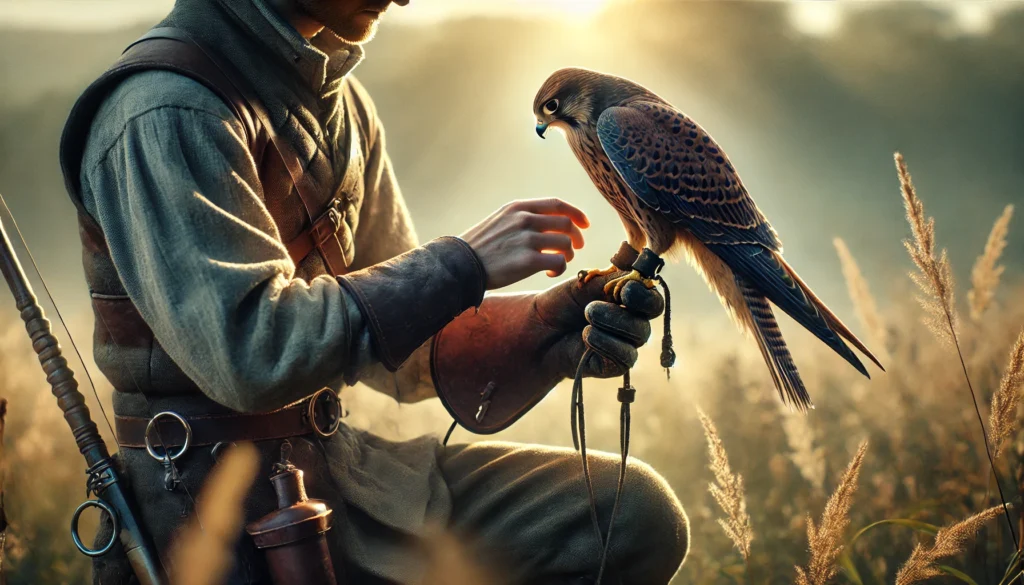Modern Falconry Techniques
- Training with Patience: Training birds of prey requires a lot of time and patience. It’s important to establish trust between the handler and the bird.
- Positive Reinforcement: Reward-based training helps build a strong bond. Treats and praise are used to encourage desired behaviors.
- Health and Nutrition: Proper diet and healthcare keep the birds strong and healthy. Regular veterinary check-ups are essential.
- Technology in Falconry: Modern tools like GPS trackers and telemetry help in locating and monitoring the birds when they fly.
- Natural Habitats: Providing an environment that mimics the bird’s natural habitat aids in more effective training and better overall well-being.
- Legal Regulations: Knowing and adhering to local and international laws ensures that falconry is practiced responsibly and ethically.
- Community and Education: Joining falconry clubs and attending workshops can help share knowledge and improve skills. Learning from experienced falconers is invaluable.
Discover the Magic of Modern Falconry Techniques
Imagine a grand, ancient Irish castle standing tall on the emerald hills, its towers reaching the sky. Just as the castle has withstood the test of time by blending old stones with new restorations, so, too, has the incredible art of falconry evolved. Welcome to Learn Falconry, where we invite you to uncover the secrets of how modern techniques are transforming this ancient sport into a captivating experience for all.
In this article, we will journey through the fascinating world of modern falconry techniques, showing you how age-old wisdom meets cutting-edge innovation. Whether you’re a curious beginner or a seasoned falconer, our goal is to make you feel like a part of our global family, united by a shared passion for these magnificent birds.
Why should you keep reading? Quite simply, understanding modern falconry techniques is like holding the key to the castle’s hidden treasures. You’ll learn about the tools and methods that make training easier, safer, and more rewarding than ever before. You’ll also gain insight into how these advancements benefit both the falconer and the bird, ensuring a harmonious and enjoyable partnership.
So, join us on this exciting adventure and let the Irish winds of knowledge guide your way through the enchanting world of modern falconry. By the end, you’ll see why keeping up with these techniques is essential for anyone passionate about this majestic art form.
Exploring Modern Falconry Techniques
Falconry has come a long way since its ancient origins. Today, the methods have evolved significantly, blending traditional practices with cutting-edge technology to enhance the experience for both the falconer and the bird. This transformation is known as modern falconry, incorporating contemporary falconry methods and new falconry techniques to improve training, performance, and the welfare of the birds.
One of the cornerstones of modern falconry is the use of GPS trackers. These devices are incredibly useful because they allow falconers to monitor their birds’ locations in real-time. This technology reduces the risk of losing a falcon during training or hunting sessions and enhances the safety of the birds. You can read more about this equipment on our Falconry Technology page.
In addition to GPS trackers, telemetry systems are also commonly used in contemporary falconry methods. These systems provide data on a bird’s speed, altitude, and direction, ensuring a more calculated approach when training and hunting. Learn more about these advancements on our Bells and Telemetry page.
Moreover, the integration of positive reinforcement techniques has revolutionized how falcons are trained. Instead of using punishment or force, falconers now use rewards and positive stimuli to encourage desired behaviors. This method not only builds a better bond between the falconer and the bird but also results in more effective and humane training. Discover further details about these techniques on our Positive Reinforcement Techniques page.
Contemporary falconry also sees the use of specialized equipment like custom falconry lures and automatic training systems. These tools are designed to simulate prey and can be remotely controlled to create more realistic training scenarios for the birds. Learn more about these innovations on our Falconry Lures page.
Another vital aspect of modern falconry is the focus on the health and nutrition of the birds. Proper nutrition not only enhances a falcon’s performance but also ensures its overall well-being. Falconers now have access to advanced nutritional supplements and balanced diet plans, ensuring their birds are in peak condition. For more information on falcon health and care, visit our Falcon Health & Nutrition section.
Lastly, the practice of modern falconry extends into urban environments, using birds for pest control and wildlife management. This application not only provides a sustainable method for managing pests but also offers a unique way to engage with the sport in different settings. Learn more about how falconry can be used in urban areas on our Urban Falconry page.
Modern Falconry Techniques in 2024
High-Tech Training
In 2024, falconry is a blend of ancient art and modern technology. Traditional techniques are being enhanced with high-tech tools to improve the performance and well-being of birds of prey. One notable advancement is the use of drones. Drones serve as effective training aids, providing flying targets that help in honing a bird’s hunting skills. GPS tracking systems are widely used to monitor the location and status of the birds during training, ensuring they are safe and on track. Below is a table showing how different technologies are utilized in modern falconry:
| Technology | Purpose |
|---|---|
| Drones | Training aids, providing moving targets |
| GPS Tracking | Monitoring bird location and status |
| Telemetry Systems | Collecting data on flight patterns and health |
Resistance Training
Resistance training is a newer approach to building the strength and endurance of birds of prey. This involves the use of devices like Berghwings and drones to provide resistance while the bird is in flight. By working against resistance, the birds develop greater muscle strength and stamina, which enhances their overall hunting abilities.
Habituation and Conditioning
Modern falconry places a significant focus on habituating and conditioning birds of prey to their training environment. This includes training birds to chase drones and other targets to stimulate their natural hunting instincts. Conditioning also involves gradually exposing the birds to various stimuli they might encounter, ensuring they remain calm and focused during actual hunts.
Monitoring and Recovery
In order to maintain the health and efficiency of raptors, telemetry systems and other monitoring tools are crucial. These systems track the flight patterns, health metrics, and recovery status of birds. This ensures that the birds do not get overworked and that they have adequate recovery periods. Let’s look at some key monitoring tools:
| Monitoring Tool | Function |
|---|---|
| Telemetry Systems | Monitoring flight patterns and health |
| Health Check Up | Regular health assessments |
| Recovery Programs | Ensuring adequate rest and recovery time |
Conservation Focus
Modern falconry is not just about improving hunting skills but also about conservation and education. Falconers participate in breeding programs, rehabilitation efforts, and educational outreach to raise awareness about the importance of preserving raptor species and their habitats. Conservation-focused training programs are designed to instill principles of wildlife protection and community engagement among falconers.
Community Engagement
Finally, community engagement is a critical component of contemporary falconry. Falconry associations and clubs around the world foster ethical practices, share knowledge, and encourage public participation. These communities serve to support the long-term viability and sustainability of the sport, providing platforms for sharing expertise and promoting ethical falconry practices.
By integrating traditional methods with cutting-edge technology, modern falconry ensures the sport’s sustainability while fostering a strong community that is dedicated to the conservation and education of raptor species.
Embracing Modern Falconry: Future and Tradition Hand in Hand
In the world of modern falconry, the integration of advanced technologies like drones, GPS tracking, and telemetry systems is revolutionizing the way falconers train and care for their magnificent birds of prey. These high-tech tools, combined with new techniques such as resistance training and telemetry-based health monitoring, allow for more efficient and effective training regimes.
Conservation efforts are another crucial aspect, with falconers actively involved in protecting raptor habitats, engaging in rehabilitation programs, safeguarding endangered species, and promoting ethical practices within the community. The incorporation of forensic DNA methods stands out as a significant advancement, aiding in the battle against illegal wildlife trade by verifying the origins of birds.
The role of education and community engagement cannot be overstated, as falconry clubs and associations worldwide foster knowledge exchange and uphold high ethical standards. Data management has also become vital, streamlining operations and ensuring precise tracking of bird health and conservation data.
These contemporary advancements showcase a harmonious blend of traditional falconry skills with modern innovations, ensuring the sustainability and relevance of the sport for generations to come. As we move forward, let’s continue to embrace these new techniques while honoring the timeless bond between falconer and bird, ensuring a future where both can thrive together.



